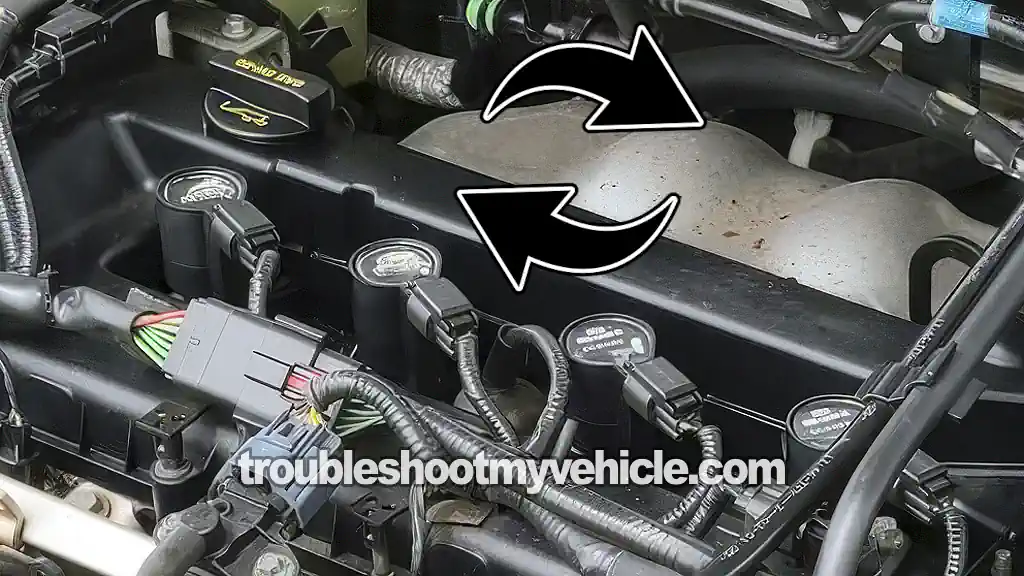
Testing the coil-on-plug (COP) ignition coils on the 2005-2010 2.0L Ford Focus is super easy, and the best part is you don't need any fancy or expensive diagnostic equipment.
In this tutorial, I'm going to show you how to find out if you've got a bad ignition coil using a spark tester. All the steps are explained in a step-by-step manner so you can quickly and easily confirm a bad coil.
Contents of this tutorial:
- Symptoms Of A Bad COP Ignition Coil.
- What Tools Do I Need To Test The COP Coils.
- Where To Buy The COP Ignition Coil And Save.
- START HERE: Checking For Cylinder Misfire Codes.
- TEST 2: Check The Ignition Coil For Spark.
- TEST 3: Swap The Non-Sparking COP Coil.
- More 2.0L Ford Focus Diagnostic Tutorials.
APPLIES TO: This tutorial applies to the following vehicles:
- 2.0L DOHC Ford Focus: 2000, 2001, 2002, 2003, 2004.
COIL PACK TESTS (2000-2004 FORD FOCUS):
Symptoms Of A Bad COP Ignition Coil
The most obvious symptom of a bad ignition coil is a cylinder misfire. This misfire will set a misfire diagnostic trouble code (DTC) that'll illuminate the check engine light:
- P0300: Random Cylinder Misfire.
- P0301: Cylinder #1 Misfire.
- P0302: Cylinder #2 Misfire.
- P0303: Cylinder #3 Misfire.
- P0304: Cylinder #4 Misfire.
Since a bad ignition coil wreaks havoc on engine performance, you're going to see one or more of the following issues:
- Rough idle.
- Engine miss (misfire) when you accelerate the vehicle.
- Smell of raw gasoline coming out of the tailpipe.
- Bad gas mileage.
- Won't pass you state's mandated annual emissions test.
What Tools Do I Need To Test The COP Coils
The most important tool you'll need to accurately diagnose a bad ignition coil is a spark tester. Any spark tester will do.
If you don't have one, I recommend the spark tester I've used my entire automotive career. It's accurate, simple to use, and the one I trust: OTC 6589 Electronic Ignition Spark Tester (Amazon affiliate link).
Where To Buy The COP Ignition Coil And Save
Once you've confirmed you've got a bad ignition coil and you're ready to swap it out, I recommend ignition coils from the following trusted brands. I've used their parts throughout my entire automotive repair career, and they've proven to be solid and reliable:
Disclosure: As an Amazon Associate, I earn from qualifying purchases. If my tutorials help you, using these links is an easy way to support the site at no extra cost to you. Thank you!
START HERE: Checking For Cylinder Misfire Codes

The very first step in diagnosing a bad ignition coil is to connect your scan tool and check for misfire codes.
Why start here? Because misfire codes tell you which cylinder is misfiring. Once you know that, you know exactly which coil to test —and that's already half the battle.
Now, depending on what your scan tool reports, you'll fall into one of the following cases:
-
Case 1: You have a specific misfire code (P0301, P0302, P0303, or P0304). This pinpoints which cylinder is misfiring. Since the 2.0L engine has 4 COP ignition coils (one per cylinder), you'll test the coil on the cylinder identified by the code.
-
Case 2: You have a P0300 Random Misfire code. This code means the misfire is affecting all four cylinders, not just one. In most cases, that rules out a single bad ignition coil as the cause. Instead, something else (like fuel or vacuum issues) is affecting the engine across the board.
-
Case 3: You have no misfire codes but the engine runs rough at idle. This is trickier, since the computer isn't flagging a specific cylinder. Here are some good next steps:
-
Run a cylinder balance test to see if you can isolate a weak cylinder.
Remove and inspect the spark plugs and coils. Look for signs of heavy wear (worn out spark plug electrodes), engine oil contamination (from a leaking valve cover gasket), or damage.
-
If needed, run a compression test to rule out mechanical issues: How To Test Engine Compression (2000-2010 2.0L Ford Focus).
-
TEST 1: Check The Ignition Coil For Spark

As you already know, the ignition coil's job is simple: supply the spark the plug needs to ignite the air-fuel mixture in the cylinder. That's it. Its whole life revolves around generating spark.
So when the COP coil fails, it just stops creating spark and that's something we can easily check it with a spark tester.
As I mentioned earlier, you can use any spark tester you have. If you don't have one, the one I use and always recommend is this one: OTC 6589 Electronic Ignition Spark Tester (Amazon affiliate link).
Alright, let's get started with the ignition coil spark test:
- 1
Remove the ignition coil from its place on the valve cover.
- 2
Connect a spark tester to the ignition coil.
- 3
Ground the spark tester with a battery jump start cable directly on the battery negative (-) terminal.
- 4
When everything is set up, have a helper crank the engine while you observe the spark tester.
- 5
The spark tester will do one of two things: Spark or not spark.
Let's take a look at your test results:
CASE 1: The ignition coil sparked. This tells you the ignition coil is OK and working.
If the cylinder still misfires (and the misfire code keeps coming back), the problem lies elsewhere. The most common causes include:
- Engine oil leaking into the spark plug well from a bad valve cover gasket.
- Carbon tracking on the spark plug.
- Low compression in the affected cylinder.
CASE 2: The ignition coil DID NOT spark. This usually indicates a bad COP ignition coil.
Before condemning the coil, we need to make sure it's receiving power and a switching (activation) signal. The easiest way to confirm is to swap in a known-good coil and retest the cylinder. For this test go to: TEST 2: Swap The Non-Sparking COP Coil.
TEST 2: Swap The Non-Sparking COP Coil

In TEST 1 you found a COP ignition coil that isn't sparking. This usually means the coil is bad, but not always.
To confirm this, the next step is to swap in another ignition coil and test for spark again.
The idea here is to connect a known-good ignition coil to the same connector that fed the non-sparking coil. Then we'll check for spark.
If the swapped-in coil sparks, it proves the connector is delivering both power and the activation signal. In other words, the original coil is the one that's bad.
OK, let's get testing:
- 1
Unplug and remove the ignition coil that did not spark.
- 2
Choose one of the other good coils that is sparking and remove it from its place.
NOTE: Verify that this coil is sparking by testing it with your spark tester (if necessary). - 3
Connect the known-good coil to the connector of the non-sparking ignition coil.
- 4
Connect your spark tester to the ignition coil.
- 5
Ground the spark tester with a jump start cable directly on the battery negative (-) terminal.
- 6
Place the non-sparking ignition coil in the location of the good one you just removed and bolt it down.
- 7
Once everything is ready, have your helper crank the engine.
- 8
The good ignition coil should spark.
Let's take a look at your test results:
CASE 1: The ignition coil sparked. This confirms that the connector of the non-sparking ignition coil is delivering both power and the activation signal that's required for the coil to spark.
This test result also confirms that the ignition coil, the non-sparking one, is toast and needs to be replaced.
When you're ready to replace the ignition coil, I want to recommend the following coils from two known automotive brands (Bosch and Motorcraft) I don't hesitate to recommend:
- BOSCH 0221504702 Ignition Coil (Amazon affiliate link).
- Motorcraft - Ignition Coil (DG541) (Amazon affiliate link).
CASE 2: The ignition coil DID NOT spark. This result means the connector is either missing power or the activation signal, which explains why the coil didn't spark in TEST 1.
Your next step is to:
- Confirm the power wire is delivering 10 to 12 Volts.
- Confirm the other wire is supplying an activation signal from the PCM.
The most likely cause of the missing power or activation signal is an open-circuit problem in the wiring between the coil connector and the PCM. Although troubleshooting those issues is beyond the scope of this tutorial, you now know the direction your diagnostic needs to take.
More 2.0L Ford Focus Diagnostic Tutorials
You can find a complete list of 2.0L Ford Focus tutorials in this index:
Here's a small sample of the tutorials you'll find in the index:
- How To Test The Throttle Position Sensor (2000-2007 2.0L DOHC Ford Focus).
- How To Test The MAF Sensor (2000-2004 2.0L Ford Focus).
- How To Test For A Blown Head Gasket (2000-2010 2.0L Ford Focus).
- How To Test Engine Compression (2000-2010 2.0L Ford Focus).

If this info saved the day, buy me a beer!




